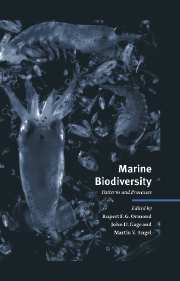Book contents
- Frontmatter
- Contents
- List of contributors
- Foreword: The value of diversity
- 1 Marine biodiversity in its global context
- 2 Gradients in marine biodiversity
- 3 Pelagic biodiversity
- 4 Biological diversity in oceanic macrozooplankton: More than counting species
- 5 Large-scale patterns of species diversity in the deep-sea benthos
- 6 Diversity, latitude and time: Patterns in the shallow sea
- 7 High benthic species diversity in deep-sea sediments: The importance of hydrodynamics
- 8 Diversity and structure of tropical Indo-Pacific benthic communities: Relation to regimes of nutrient input
- 9 Why are coral reef communities so diverse?
- 10 The biodiversity of coral reef fishes
- 11 The historical component of marine taxonomic diversity gradients
- 12 Population genetics and demography of marine species
- 13 Discovering unrecognised diversity among marine molluscs
- 14 Ecosystem function at low biodiversity – the Baltic example
- 15 Land–seascape diversity of the USA East Coast coastal zone with particular reference to estuaries
- 16 The development of mariculture and its implications for biodiversity
- 17 Protecting marine biodiversity and integrated coastal zone management
- 18 Conserving biodiversity in North-East Atlantic marine ecosystems
- Author index
- Species index
- Subject index
8 - Diversity and structure of tropical Indo-Pacific benthic communities: Relation to regimes of nutrient input
Published online by Cambridge University Press: 04 August 2010
- Frontmatter
- Contents
- List of contributors
- Foreword: The value of diversity
- 1 Marine biodiversity in its global context
- 2 Gradients in marine biodiversity
- 3 Pelagic biodiversity
- 4 Biological diversity in oceanic macrozooplankton: More than counting species
- 5 Large-scale patterns of species diversity in the deep-sea benthos
- 6 Diversity, latitude and time: Patterns in the shallow sea
- 7 High benthic species diversity in deep-sea sediments: The importance of hydrodynamics
- 8 Diversity and structure of tropical Indo-Pacific benthic communities: Relation to regimes of nutrient input
- 9 Why are coral reef communities so diverse?
- 10 The biodiversity of coral reef fishes
- 11 The historical component of marine taxonomic diversity gradients
- 12 Population genetics and demography of marine species
- 13 Discovering unrecognised diversity among marine molluscs
- 14 Ecosystem function at low biodiversity – the Baltic example
- 15 Land–seascape diversity of the USA East Coast coastal zone with particular reference to estuaries
- 16 The development of mariculture and its implications for biodiversity
- 17 Protecting marine biodiversity and integrated coastal zone management
- 18 Conserving biodiversity in North-East Atlantic marine ecosystems
- Author index
- Species index
- Subject index
Summary
Abstract
Major regional and local differences in the composition and structure of shallow-water communities in the Indo-Pacific marine province may be related to differences in nutrient availability. Animals in eutrophic environments tend to be fast-growing, with rapid population turnover and generalist habits. Bivalves, for instance, are much more diverse and abundant in eutrophic ‘continental’ environments, than on oceanic, oligotrophic atolls and reefs. Neogastropods with generalist diets include Babylonia, which are restricted to continental shores, and Nassariidae species, which are much more diverse in eutrophic environments. A comparison of food webs, involving predatory gastropods from oligotrophic and eutrophic environments, shows that the oligotrophic webs are based upon benthic algae and detritus, whilst the eutrophic webs are based upon phytoplankton. There is some evidence that rates of evolutionary diversification may be related to nutrient regimes.
Introduction
The shallow-water biota of the Indo-Pacific marine province is characterised both by the very high species diversity, but also by the very broad geographical ranges of many species, some encompassing the entire area of the province (Kohn, 1983; Kohn & Perron, 1994). Considerable attention has been given to the analysis of the biogeographical patterns and origins of this diversity in relation to plate and local tectonic history, dispersal barriers, habitat diversity, temperature, and so on (Kohn, 1983; Kay, 1984; and general review by Rosen, 1988).
- Type
- Chapter
- Information
- Marine BiodiversityPatterns and Processes, pp. 178 - 200Publisher: Cambridge University PressPrint publication year: 1997
- 10
- Cited by



